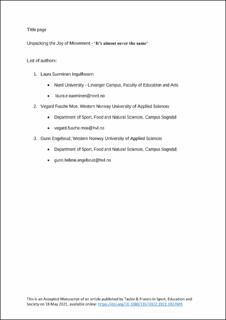| dc.contributor.author | Ingulfsvann, Laura Elina Suominen | |
| dc.contributor.author | Moe, Vegard Fusche | |
| dc.contributor.author | Engelsrud, Gunn Helene | |
| dc.date.accessioned | 2021-09-16T06:58:38Z | |
| dc.date.available | 2021-09-16T06:58:38Z | |
| dc.date.created | 2021-05-19T07:58:17Z | |
| dc.date.issued | 2021 | |
| dc.identifier.citation | Ingulfsvann, L. S., Moe, V. F., & Engelsrud, G. (2021). Unpacking the joy of movement – ‘it’s almost never the same’. Sport, Education and Society, 1-14. | en_US |
| dc.identifier.issn | 1357-3322 | |
| dc.identifier.uri | https://hdl.handle.net/11250/2778444 | |
| dc.description | This is an Accepted Manuscript of an article published by Taylor & Francis in Sport, Education and
Society on 18 May 2021, available online: https://doi.org/10.1080/13573322.2021.1927695 | en_US |
| dc.description.abstract | Researchers, politicians, physical educators, and children – all advocate the significance of joy of movement. Children desire movement because they find it joyful and meaningful, while politicians and physical educators are often interested in the associations between joy of movement and participation in physical activity. Researchers have different perspectives both on what joy of movement is and what it means for human beings. Our aim in this article is to try to understand how joy of movement emerges and evolves, and how children express it. We ask: when and where do children experience movement as enjoyable, and how can the children’s descriptions and our observations contribute to unpacking the joy of movement? We have chosen an affect theoretical perspective, which allows us to explore and analyse intensities and atmospheres and how children are affected by and ‘taken with’ activities and situations in which movement takes place. The analysis builds on qualitative material from four primary schools in Western Norway. Through in-depth analysis of writings, interviews and observations with 10- to 11-year-old children, we demonstrate that the joy of movement is both a pleasant state to which children are attracted and a force that provides them with feelings of belongingness as well as confidence and the courage to engage in new situations and interactions with others. We show how joy of movement grows, emerges, fades, and stays latent. In addition, how the intensities and forms of joy fluctuate across situations, environments, individuals and over time. The findings extend the knowledge base of what joy of movement can be and provide a basis to discuss the educational values of joy of movement and pedagogical implications. We suggest that considering situational and relational aspects of joy of movement is important when legitimating the educational value of movement and when facilitating joy of movement in PE. | en_US |
| dc.language.iso | eng | en_US |
| dc.publisher | Taylor & Francis | en_US |
| dc.subject | joy of movement | en_US |
| dc.subject | physical education | en_US |
| dc.subject | affect theoretical perspective | en_US |
| dc.subject | qualitative research | en_US |
| dc.subject | children | en_US |
| dc.title | Unpacking the joy of movement – ‘it’s almost never the same’ | en_US |
| dc.type | Peer reviewed | en_US |
| dc.type | Journal article | en_US |
| dc.description.version | acceptedVersion | en_US |
| dc.subject.nsi | VDP::Samfunnsvitenskap: 200::Samfunnsvitenskapelige idrettsfag: 330::Idrettspedagogikk og -psykologi: 333 | en_US |
| dc.source.journal | Sport, Education and Society | en_US |
| dc.identifier.doi | 10.1080/13573322.2021.1927695 | |
| dc.identifier.cristin | 1910625 | |
| dc.description.localcode | Available 2022-11-18 | |
| cristin.ispublished | true | |
| cristin.fulltext | postprint | |
| cristin.qualitycode | 2 | |
